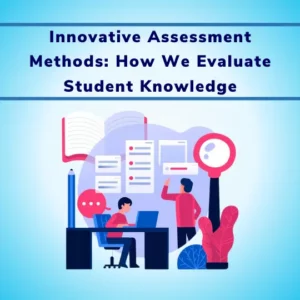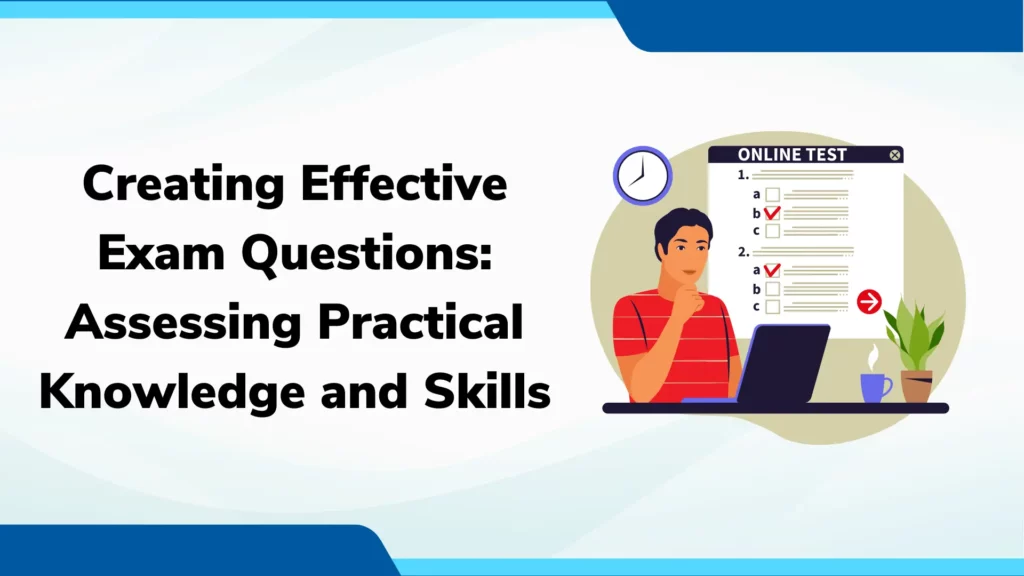
Article Contents
Introduction
In today’s rapidly changing world, traditional exams face criticism for their heavy emphasis on theoretical knowledge, often overlooking practical application and problem-solving skills. This limitation poses a challenge for educators who aim to prepare students for real-world scenarios and meet the demands of modern industries.
To address this gap, innovative question design techniques are crucial in creating exams that effectively assess practical knowledge and skills, fostering outcome-based education. By adopting a student-centric approach, educators can create question papers that empower students to excel in their future careers.
In this blog post, we will explore strategies and best practices for developing exam questions that transcend classroom concepts, evaluate practical knowledge, and equip students for success in their professional journeys.
Understanding the Limitations of Traditional Exams
Traditional exams have received criticism due to their limitations. These exams primarily emphasize memorizing and repeating information, without assessing students’ capacity to apply knowledge in practical situations. Normally educators neglect vital skills such as problem-solving, critical thinking, creativity, and collaboration, which are crucial for professional success.
Educators need to acknowledge these limitations and explore avenues to improve assessment methods. By doing so, they can better evaluate students’ abilities and adequately prepare them for real-world challenges. By moving beyond traditional exams, educators can foster a more comprehensive learning experience that nurtures a broader skill set and equips students with the tools necessary for success in their future endeavours.
This shift can lead to a more holistic and effective education system that prioritizes practical application, critical thinking, and collaboration skills. By incorporating real-life scenarios and practical challenges into assessments, educators can bridge the gap between classroom learning and real-world application, enabling students to see the relevance of their knowledge and develop essential skills that extend beyond mere memorization.
Therefore, it is imperative for educators to adapt and innovate assessment methods to ensure that students are adequately prepared for the multifaceted challenges of the future.
The Importance of Assessing Practical Knowledge and Skills
In the rapidly evolving world we live in, theoretical knowledge alone is no longer enough to succeed. Employers and industries seek professionals who can apply their knowledge in practical ways, effectively tackling complex problems and adapting to changing circumstances.
This is why assessing practical knowledge and skills has become increasingly important in education. By evaluating students’ ability to apply their knowledge in real-life situations, educators ensure that they are equipped with the necessary skills to excel in their future careers.
Practical assessments go beyond the memorization of facts and encourage students to think critically and analytically. They provide opportunities for students to engage with real-world scenarios and apply their knowledge to solve practical problems. By immersing themselves in these assessments, students develop a deeper understanding of the subject matter and gain valuable hands-on experience.
Moreover, practical assessments cultivate the development of innovative thinking. Students are encouraged to explore different perspectives, come up with creative solutions, and think outside the box. These assessments support a deeper level of engagement and active learning, as students are actively applying their knowledge to real-life challenges.
By assessing practical knowledge and skills, educators bridge the gap between theoretical learning and real-world application. They ensure that students not only possess the required knowledge but also have the ability to utilize that knowledge effectively.
This type of assessment prepares students for the complexities of their future careers, equipping them with the problem-solving abilities, critical thinking skills, and adaptability required in today’s dynamic professional landscape.
Strategies for Creating Effective Exam
1. Aligning Exam Questions with Real-Life Scenarios
To assess practical knowledge effectively, exam questions should go beyond theoretical concepts and align with real-life scenarios. By presenting students with practical problems, educators can gauge their ability to analyze and apply their knowledge in meaningful ways.
These questions should simulate challenges that professionals encounter in their respective fields, requiring students to demonstrate critical thinking, problem-solving, and decision-making skills. By incorporating real-life scenarios, exam questions encourage students to bridge the gap between theory and practice, preparing them for the complexities of their future careers.
This approach promotes a deeper understanding of the subject matter and ensures that students are equipped with the practical skills necessary for success in the real world.
Effective exam questions are the bridge between theoretical understanding and practical application.
2. Scenario-Based Questions
Scenario-based questions offer a valuable approach to assessing students’ practical knowledge and skills. By presenting real-world situations relevant to the subject, these questions require students to apply their knowledge and skills to solve problems or make decisions.
They provide a context in which students can demonstrate their understanding and showcase their ability to transfer knowledge to practical scenarios. Scenario-based questions also foster critical thinking and problem-solving abilities as students analyze the situation, consider different perspectives, and propose appropriate solutions.
By incorporating these types of questions, educators can assess students’ readiness to tackle real-life challenges and ensure the development of practical competencies in the subject area.
From textbooks to action, effective exam questions bridge the gap between learning and real-world application.
For example, you could provide a case study and ask students to analyze the data, choose the appropriate AI algorithm, and explain how they would implement it.
3. Incorporating Problem-Solving and Critical Thinking
Encouraging problem-solving and critical thinking skills is essential in the modern world. Exam questions should challenge students to analyze complex situations, evaluate alternatives, and propose viable solutions.
This approach assesses not only their theoretical understanding but also their ability to think critically and apply knowledge creatively. By challenging them to analyze complex situations, evaluate alternatives, and propose solutions, educators can assess their ability to think critically and apply knowledge creatively.
These types of questions go beyond rote memorization and encourage students to think deeply, reason logically, and consider multiple perspectives. By fostering problem-solving and critical thinking skills, educators empower students to become adaptable and resourceful individuals capable of addressing the challenges they may encounter in their academic and professional lives.
4. Coding and Programming Questions
To effectively assess practical programming skills, incorporating coding questions is essential. These questions prompt students to write code to solve specific problems, such as implementing algorithms, performing data preprocessing tasks, training models, or evaluating model performance.
By including coding questions, educators can evaluate students’ ability to apply programming concepts and techniques to real-world scenarios. Utilizing a question paper generator can streamline the process by automating the creation of coding questions with predefined constraints and evaluation criteria.
This approach not only assesses students’ coding proficiency but also enhances their problem-solving, algorithmic thinking, and software development abilities, preparing them for practical applications in the field of programming and beyond.
5. Implement Regular Online Exams
To keep pace with the ever-evolving world, it is essential to introduce regular online exams. Online assessments provide flexibility and scalability, allowing educators to assess students’ skills more frequently.
Choose a reputable online assessment platform that aligns with your requirements. Ensure that the platform offers features such as secure test delivery, question randomization, and various question types (multiple choice, essay, etc.).
Create a variety of assessment formats that align with the learning objectives and content of your courses. Consider using a mix of multiple-choice questions, short-answer questions, essays, and practical assignments to evaluate different skills and knowledge levels.
6. Aligning Assessments with Learning Objectives
Aligning exam questions with the intended learning outcomes of a course or curriculum is of utmost importance for several reasons. Firstly, it ensures that the assessments are directly linked to what students are expected to learn, enabling a clear and coherent evaluation of their understanding.
This alignment promotes a focused and purposeful approach to teaching and learning, as educators can design instructional activities and assessments that are closely tied to the desired outcomes. Furthermore, it enhances the validity and reliability of assessments, as they accurately measure the knowledge and skills students are expected to acquire.
By aligning assessments with learning objectives, educators can also provide meaningful feedback to students, guiding them on areas that require improvement and reinforcing their achievements.
7. Integrating Multidisciplinary Approaches
Today’s challenges often require a multidisciplinary perspective. Exam questions should encourage students to integrate knowledge from various subjects and apply them to real-world problems. This approach fosters a holistic understanding of how different fields intersect and prepares students for the interdisciplinary nature of modern industries.
In today’s rapidly evolving world, many challenges are complex and interconnected, demanding a multidisciplinary perspective for effective solutions. As educators, it is essential to design exam questions that encourage students to integrate knowledge from various subjects and apply them to real-world problems. By doing so, we foster a holistic understanding of how different fields intersect and complement each other, preparing students for the interdisciplinary nature of modern industries.
For example, an exam question might ask students to analyze the impact of climate change on a specific ecosystem. To answer this question comprehensively, students would need to draw upon their knowledge of environmental science, biology, chemistry, and even social sciences.
They would need to understand the ecological interactions within the ecosystem, the chemical processes contributing to climate change, and the socio-economic factors influencing its mitigation or adaptation strategies.
By incorporating multidisciplinary approaches into exam questions, we encourage students to break free from the traditional boundaries of individual subjects and recognize the interconnectedness of knowledge.
8. Performance-Based Assessment
Performance-based assessment methods offer a valuable approach to evaluating students’ practical knowledge and skills. By incorporating hands-on projects or practical demonstrations, educators can assess students’ ability to apply their knowledge in real-world contexts.
These assessments provide opportunities for students to develop and deploy systems, analyze results, and troubleshoot issues, mirroring the tasks they would encounter in professional settings. Performance-based assessments not only measure students’ practical abilities but also foster collaboration, problem-solving, and critical thinking skills.
By engaging in these real-world tasks, students gain valuable experience and develop the confidence needed to excel in their chosen fields.
9. Integrating Multidisciplinary Approaches
In today’s complex world, challenges frequently demand a multidisciplinary perspective to be effectively addressed. By integrating knowledge from various subjects, students gain a comprehensive understanding of real-world problems and acquire the skills to approach them holistically.
Encouraging students to apply their diverse knowledge to interdisciplinary scenarios prepares them for the collaborative nature of modern industries, where solutions often require expertise from multiple fields.
Such an approach fosters creativity, critical thinking, and the ability to connect different domains, enabling students to tackle complex issues with innovative and well-rounded solutions. Emphasizing the integration of multidisciplinary approaches equips students with valuable tools for success in the interconnected world of the 21st century.
10. Rubrics and Scoring Guidelines
Clear rubrics and scoring guidelines play a vital role in maintaining consistency and objectivity when evaluating students’ responses. By providing explicit criteria for assessment, these guidelines establish a common understanding of expectations and standards.
They enable educators to evaluate student work in a fair and unbiased manner, ensuring a level playing field for all students. Furthermore, rubrics and scoring guidelines help students understand what is expected of them, enabling them to focus their efforts on meeting specific criteria.
By including a scale or point distribution, these guidelines provide a transparent framework for assessing different levels of performance, facilitating accurate and meaningful feedback to support student growth and improvement.
11. Pilot Testing
Pilot testing is a crucial step in the exam preparation process as it allows for the identification and rectification of any issues with the questions. By administering the questions to a sample group of students or colleagues, ambiguities, errors, or gaps can be identified and addressed before the actual exam.
This process ensures that the questions are clear, and accurate, and effectively evaluates the intended learning outcomes. Feedback from the pilot test participants provides valuable insights and perspectives that contribute to refining the questions and enhancing their overall quality. Pilot testing ultimately leads to more reliable and valid assessments that accurately measure student knowledge and understanding.
Enhancing Exam Systems: Beyond Traditional Assessments
Creating effective exam questions is only one aspect of enhancing the assessment process. Educators should also consider the following strategies to develop a comprehensive and student-centric exam system:
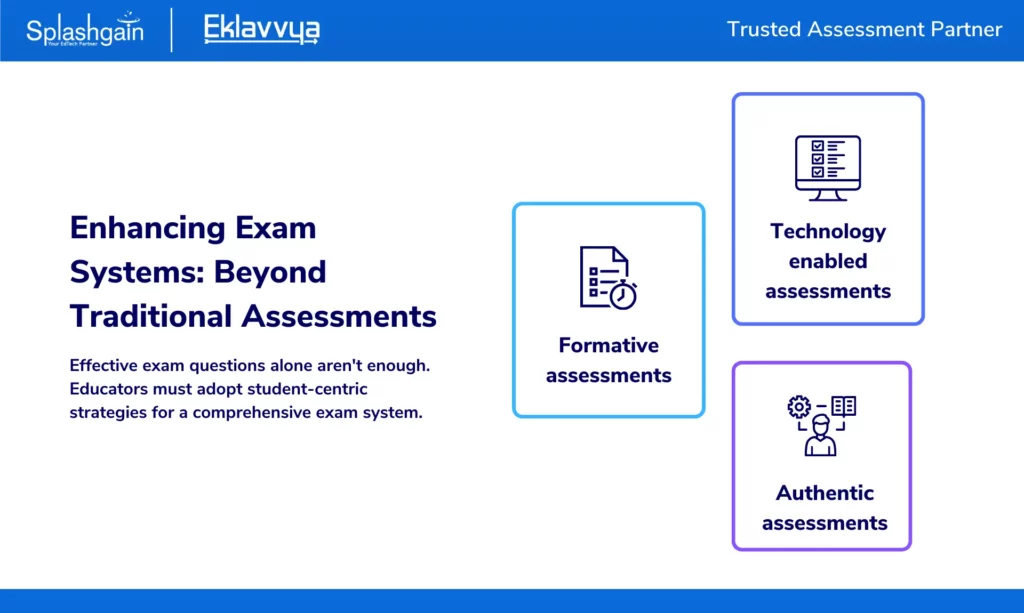
1. Formative Assessments
Integrate formative assessments throughout the learning process to provide continuous feedback and identify areas where students require further support. These assessments can take the form of quizzes, presentations, or practical demonstrations, allowing students to apply their knowledge in an ongoing manner.
Quizzes are a popular form of formative assessment that assesses students’ comprehension of specific concepts or topics. They not only provide immediate feedback to students but also enable educators to evaluate the effectiveness of their teaching strategies. By identifying areas where students struggle or excel, educators can tailor their instruction to meet individual needs and provide targeted support.
Presentations offer an opportunity for students to showcase their understanding and communication skills. By presenting a topic to their peers or educators, students demonstrate their ability to organize information, articulate ideas, and engage with the subject matter. This form of formative assessment encourages students to think critically, enhance their presentation skills, and receive constructive feedback to further improve their abilities.
Practical demonstrations give students the chance to put their knowledge into action through hands-on activities. This can involve conducting experiments, solving real-life problems, or showcasing specific skills. These activities provide valuable opportunities for students to apply what they have learned in a practical way, enhancing their overall learning experience.
2. Authentic Assessments
Authentic assessments are a valuable tool in education that involve real-world tasks and projects, mirroring the challenges professionals face. By simulating authentic scenarios, students have the opportunity to demonstrate their abilities and readiness for the workforce.
These assessments go beyond theoretical knowledge and focus on practical application, allowing students to showcase their skills in real-life situations.
The relevance of these assessments to the student’s future careers enhances motivation and engagement, as they can see the direct connection between what they are learning and its real-life applications. Authentic assessments foster critical thinking, problem-solving, and collaboration, which are vital skills in professional settings.
By incorporating authentic assessments, educators bridge the gap between classroom learning and the complexities of the professional world. These assessments provide a comprehensive evaluation of students’ preparedness for their future careers and help them develop the confidence and competence required to succeed in their chosen fields.
3. Technology-Enabled Assessments
Leverage technology to create interactive assessments that go beyond traditional pen-and-paper exams. Online platforms, simulations, and virtual environments offer opportunities for students to engage with complex scenarios, receive immediate feedback, and demonstrate their practical skills in a digital format.
Technology has revolutionized assessment practices by offering numerous benefits to educators. Online platforms provide a convenient and efficient way to administer assessments, enabling students to complete tasks from anywhere, anytime.
For example, platforms like Eklavvya’s AI-driven question paper tool, Google Classroom or learning management systems, Eklavvya’s centre based exam, Descriptive Test allow educators to create and distribute quizzes, assignments, and exams digitally.
Additionally, automated grading systems alleviate the burden of manual grading, saving educators valuable time. These systems use algorithms to assess multiple-choice questions, short answers, and even some essay responses. Moreover, data analytics provides educators with valuable insights into student performance.
For instance, learning analytics tools can analyze student data, identify trends, and generate reports that help educators understand individual and class-wide strengths and weaknesses. This information allows educators to provide timely feedback and targeted interventions, ultimately enhancing the learning experience for students.
The Role of AI-Generated Question Papers
AI-generated question papers offer significant benefits in terms of efficiency, consistency, and diversity. Eklavvya, an AI-driven question paper tool, automates the evaluation and results process, saving valuable time for educators.
This tool harnesses the power of machine learning algorithms to generate question papers based on predefined parameters, ensuring that assessments align with the desired learning outcomes and Bloom’s Taxonomy levels. By automating the question paper generation process, educators can focus on other essential aspects of teaching and learning.

AI-powered precision: automated question papers streamline evaluation, saving time and ensuring learning objectives are met.
Best Practices for Effective Exam Questions
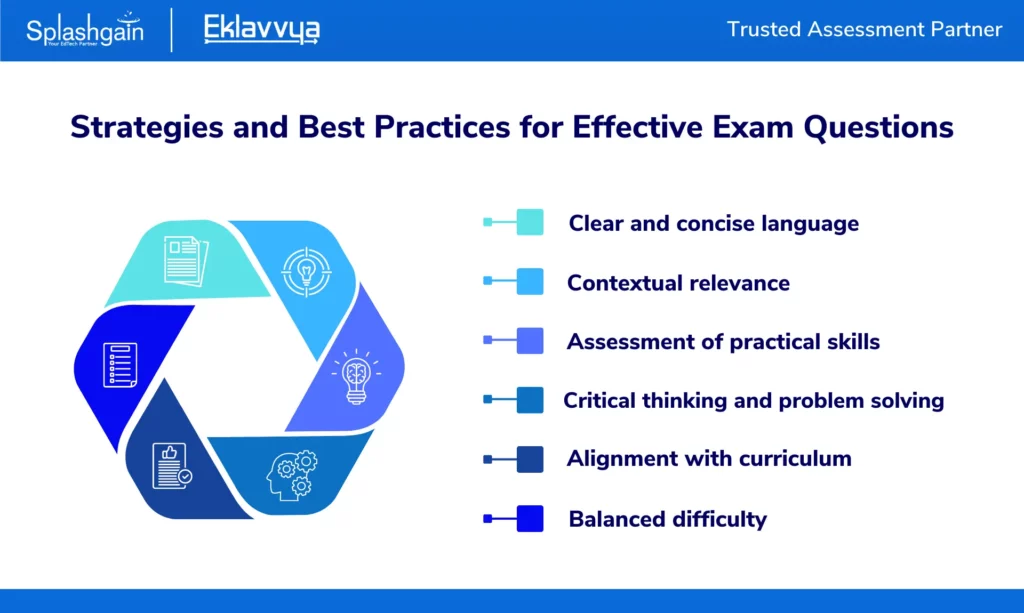
1. Clear and Concise Language
It is crucial to use clear and concise language when phrasing exam questions. Ambiguity or complex wording can lead to confusion and misinterpretation among students. Questions should be straightforward and avoid unnecessary jargon or technical terms that may hinder understanding.
By using simple language, educators can ensure that students focus on the content and concepts being assessed rather than getting lost in convoluted sentence structures.
2. Contextual Relevance
Exam questions should be framed in a manner that reflects real-world scenarios and contexts. This approach enables students to apply their knowledge and skills effectively to practical situations. By presenting questions that simulate or resemble authentic scenarios, educators can assess students’ ability to transfer their learning to real-life contexts.
This strategy encourages students to think critically and make connections between theoretical concepts and their practical application.
3. Assessment of Practical Skills
In addition to assessing theoretical knowledge, exam questions should incorporate tasks that require students to demonstrate practical skills. This can be achieved through simulations, case studies, or hands-on tasks that mirror real-life situations.
By including questions that assess practical skills, educators can evaluate students’ ability to apply their knowledge in practical contexts and gauge their competency beyond rote memorization.
4. Critical Thinking and Problem-Solving
Effective exam questions should go beyond simple recall or regurgitation of information. They should challenge students to engage in critical thinking, analysis, evaluation, and problem-solving. These types of questions encourage higher-order thinking skills and promote deeper understanding and application of knowledge.
By posing questions that require students to analyze and evaluate information, educators can assess their ability to think critically and solve complex problems.
5. Alignment with Curriculum
Exam questions should align with the learning objectives outlined in the curriculum. They should reflect the desired learning outcomes, ensuring that the assessment accurately measures students’ achievement of the intended goals.
By closely aligning exam questions with the curriculum, educators can assess students’ mastery of specific concepts and skills that have been taught and emphasized during the instructional period.
6. Balanced Difficulty
It is important to strike a balance between easy, moderate, and challenging questions while designing exams. This ensures that students of varying abilities are appropriately challenged and assessed. Including a range of difficulty, levels allow educators to gauge students’ proficiency at different levels of complexity.
It also prevents demotivation among students who might find the assessment too easy or overwhelming. By providing a comprehensive mix of questions, educators can obtain a more accurate representation of students’ overall understanding and performance.
Overall, AI-driven question paper tools provide educators with a streamlined and efficient approach to assessment. The questions are framed in a manner that reflects real-world scenarios and contexts, enabling students to apply their knowledge and skills effectively.
The machine learning algorithms used in these tools generate questions based on pre-defined parameters, ensuring that assessments accurately measure students’ achievement of the intended goals. This alignment with curriculum objectives enables educators to assess students’ mastery of specific concepts and skills that have been taught and emphasized during the instructional period.
By automating the evaluation and results process, these tools save time and enable educators to focus on other essential aspects of teaching and learning.
Conclusion
In conclusion, the evolution of exams is imperative to meet the ever-changing demands of the modern world. Traditional exams, with their narrow focus on theoretical knowledge, fail to adequately prepare students for real-world challenges.
By embracing innovative question design techniques, educators can create exams that assess practical knowledge and problem-solving skills, fostering outcome-based education. By incorporating AI-generated question paper tools educators can design assessments that align with the demands of the modern world.
Strategies such as clear language, contextual relevance, practical skill assessment, and promoting critical thinking can enhance the quality of exam questions. By designing effective exam questions that align with real-life scenarios, emphasize problem-solving and critical thinking, and integrate multidisciplinary approaches, educators can better prepare students for the demands of modern industries.
Furthermore, tools like Eklavvya’s AI-driven question paper tool provide automation and time-saving benefits, allowing educators to focus on generating high-quality question papers. Also Eklavvya’s assessment and configure test features are beneficial to the educational institute.

By embracing these practices, educators can ensure that assessments provide an accurate measure of students’ abilities and support their holistic development.
Ensure clarity and precision in your exam questions by using concise language and avoiding ambiguity. Create questions that assess higher-order thinking skills by requiring students to analyze, apply, evaluate, or create rather than simply recall information.
Design scenario-based questions that simulate real-world situations and require students to apply their knowledge and skills to solve problems.
AI-generated question papers can enhance exam systems by providing a diverse range of practical scenarios, promoting critical thinking, problem-solving, and real-life application of knowledge, thus aligning with outcome-based education objectives and accreditation requirements.
Traditional exams focus predominantly on theoretical knowledge, disregarding practical application and problem-solving skills required in today’s industries, thus warranting an upgrade to better assess practical knowledge and skills.


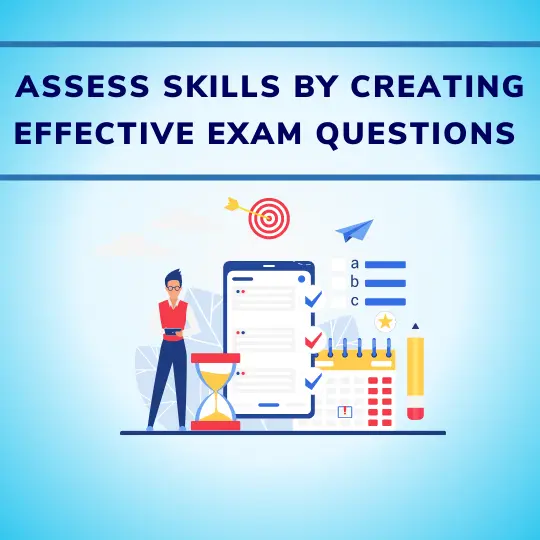
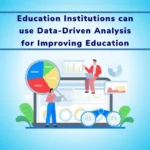
![How Government-Led Exams at 250+ Locations Are Setting New Standards of Integrity [Case Study]](https://www.eklavvya.com/blog/wp-content/uploads/2024/04/Enhancing-Exam-Integrity-Government-Certification-in-250-Locations-150x150.webp)
![Transforming Central Govt. Exams Evaluation: How Onscreen Marking is Leading the Charge [Case Study]](https://www.eklavvya.com/blog/wp-content/uploads/2024/04/How-Onscreen-Marking-Revolutionized-Central-Govt-Exams-Case-Study-1-150x150.webp)
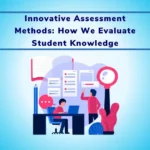
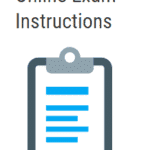
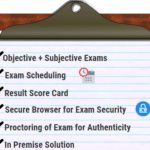
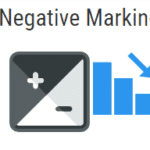









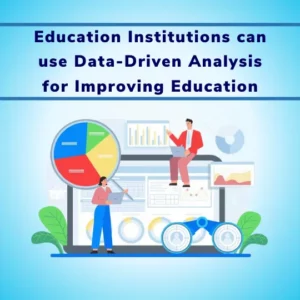
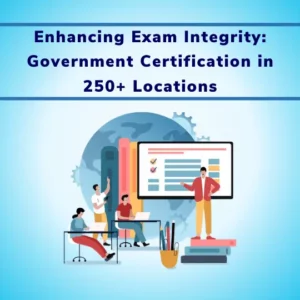
![How Onscreen Marking Revolutionized Central Govt Exams [Case Study]](https://www.eklavvya.com/blog/wp-content/uploads/2024/04/How-Onscreen-Marking-Revolutionized-Central-Govt-Exams-Case-Study-1-300x300.webp)
